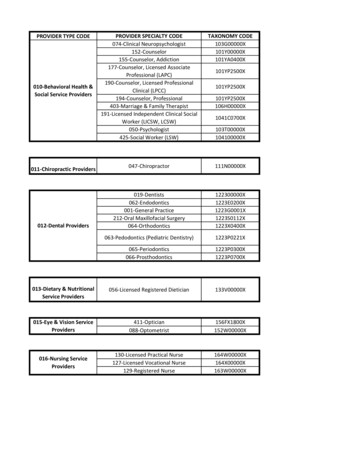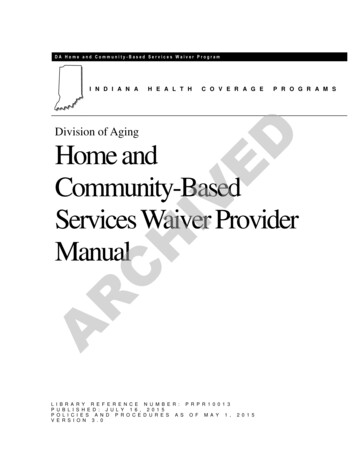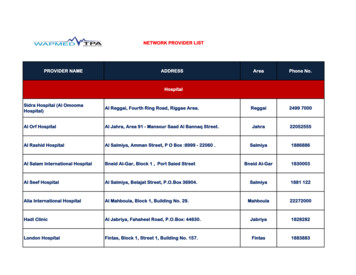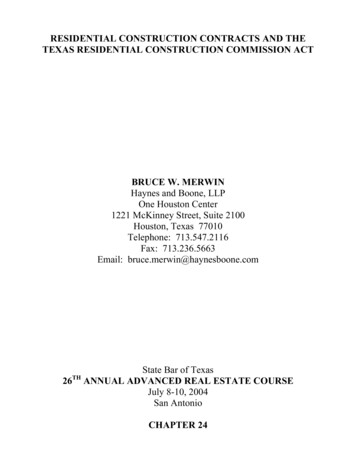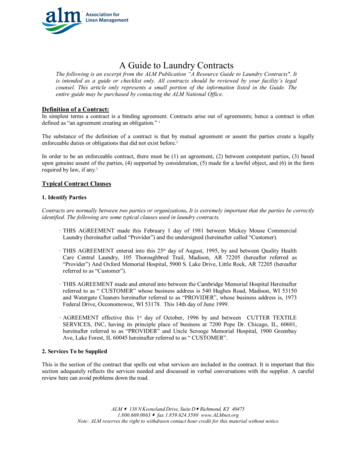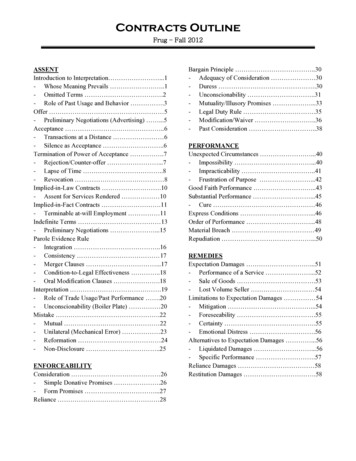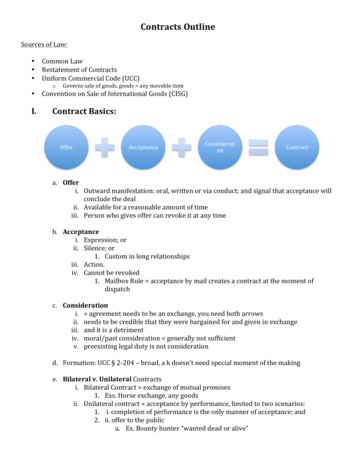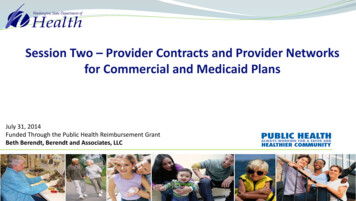
Transcription
Session Two – Provider Contracts and Provider Networksfor Commercial and Medicaid PlansJuly 31, 2014Funded Through the Public Health Reimbursement GrantBeth Berendt, Berendt and Associates, LLC
Session Overview Introduction and Brief Review of Key Terms Role of Insurance Commissioner vs. Health Care Authority Types of Health Issuers – and the products they sell Medicaid Managed Care Plans – and “Churn” In-network vs. out-of-network status Provider Networks and Network Adequacy Essential Community Providers – how they are part of a QHP’s network Intro to the Provider Contract – key provisions Intro to the Compensation Exhibit Questions
Key Terms “Essential Community Provider” -are providers that serve predominantly low-income, medically underserved populations and in Washington State – TheInsurance Commissioner defines and Essential Community Provider under WAC284-43 -221 see: http://apps.leg.wa.gov/wac/default.aspx?cite 284-43-221 “Health Benefit Plan” – The health coverage product defined by the: covered services (Essential Health Benefits plus any additional benefits added by theissuer) the limitations/exclusions, the cost sharing (deductible, copays & coinsurance); and network “Issuer” – the type of health carrier that provides the health care coverage- InWashington there are 3 different types of issuers: Health Care Service Contractor - such as Premera BlueCross, Regence BlueShield Health Maintenance Organization (HMO) such as Group Health Cooperative Disability Insurance Company – such as United Healthcare and Aetna
Key Terms “Network" means the group of participating providers and facilitiesproviding health care services to a particular health plan or line ofbusiness (individual, small, or large group). A health plan network forissuers offering more than one health plan may be smaller in number thanthe total number of participating providers and facilities for all plansoffered by the carrier “Non-network Provider”– A provider or facility that is not under contractand may bill the Commercial patient for all charges not paid by issuer(balance billing) (Apple Health has exceptions around hospitalization) “Participating Provider” – A provider or facility that has a signed contractwith an issuer and agrees to look solely to the issuer for payment ofcovered services (hold harmless provision) – may not balance bill thepatient even if issuer does not pay the claim
Key Terms “Office of Insurance Commissioner (OIC)” – the primary regulator ofinsurance – enforces both state and federal law including the ACA. “Qualified Health Plan or QHP” – an individual or small group healthbenefit plan that is purchased through the Health Benefit Exchange –Washington Healthplanfinder. QHPs are not issued to Medicaidbeneficiaries “Service Area” the geographic area or areas where a specific product isissued, accepts members or enrollees, and covers provided services. Aservice area must be defined by the county or counties unless thecommissioner permits limitation of a service area by zip code due togeographic barriers within a service area, or other conditions that makeoffering coverage throughout an entire county unreasonable.
Do you know the role of the Health Care Authority vs. the Office of theInsurance Commissioner in the contracting process?
Role of the OIC vs. Health Care Authority The OIC reviews and approves the health benefit plan contracts; the rates;the provider contracts, and provider networks for all individual and smallgroup products sold on the Exchange (QHPs) and outside market. The Health Benefit Exchange Board cannot certify a plan as QHP unless ithas been approved by the OIC The Health Care Authority (HCA) contracts with the managed careMedicaid plans that offer “Apple Health” products. The HCA reviews the Apple Health networks for adequacy but the OICapproves the provider contracts
Regulation of Various Types of “Insurance” Programs & Networks“Insurance” ProgramDescriptionWho Regulates or Controls?Who regulates the Network?Commercial Insurance – Insidethe ExchangeThe health benefit plans known as Qualified Health Plans (QHPs) and QualifiedDental Plans (QDPs) available for individuals and small groups ( 50) through theHealth Benefit Exchange (HBE.) These are fully insured products that mustcomply with the state insurance code and the Affordable Care Act (ACA.)1)The OIC must approve thehealth benefit plans andnetworks and regulates theissuersThe Health Benefit ExchangeCertifies the QHPs and QDPsfor Washington1)The OIC enforces state andfederal lawFederal Governmentestablishes ACArequirements through rulemaking but delegatesenforcement to OIC1)Health Care Authority –provides primary oversightOIC licenses the companiesand approves providercontracts1)2)QHPs must contract with at least some of each type of “willing” EssentialCommunity Providers and cover Essential Health Benefits2)3)Coverage is for enrollees who do not qualify for Medicaid – but may be eligiblefor tax credits and cost sharing reductions if under 400% FPLCommercial Insurance –Outside of the ExchangeAll fully insured individual, small group and large group insurance products soldoutside of the HBE.1)2)Individual and small group non-grandfathered plans must cover EssentialHealth Benefits – but do not have to contract with Essential CommunityProvidersManaged Care Medicaid“Apple Health”Program for low income for individuals – including children at or below 138%FPL1)2)2)OIC reviews network foradequacyHealth Benefit ExchangeCertifies Network As part ofQualified Health PlanCertificationFederal Governmentprovides authority underfederal lawThe OIC reviews thenetwork for Adequacyunder state lawFederal Governmentprovides authority underfederal lawThe HCA
Types of Issuers- and the products they sell It is important to understand the type of issuer because they are governedby different laws and rules – and there are 3 main “types” Health Care Service Contractors (HCSCs)– These types of issuers receive aCertificate of Registration from the OIC and are “exempt from the laws ofinsurance” when they provide “pre-paid health care services” throughnetworks of participating providers The distinction is not quite as important as in previous years but it used to bea far less burdensome regulatory scheme Most of the health issuers in the individual and small group market are HCSCs Examples are Premera Blue Cross, Regence BlueShield of Washington;Lifewise of Washington to name a few
Types of Issuers- and the products they sell Health Maintenance Organizations – or HMOs – must provide all of theirservices (except for emergency services) through networks of participatingproviders and unlike the HCSCs they must provide the full range of health careservices (hospital, physician services, lab and X-ray etc.) and may not issuestand alone products such as dental or vision only. Examples in Washington are: Molina; Group Health Cooperative andCoordinated Care Some HMOs are called “staff model” HMOs and actually run their own hospitalsand employ the medical staff –or combine both staff provided services andnetwork providers- Group Health is a “staff model HMO”
Types of Issuers- and the products they sell The third type of “issuer” are disability insurance companies – or ‘true insurers.’ These companies are authorized to sell many different types ofinsurance products – with health insurance being just one type of productOther types of products from disability insurers include disability income;accidental death and dismemberment; specified disease such as canceronly indemnity productsDisability Insurers are not required to provide their health insuranceproducts utilizing “network providers” – but virtually all of them doDisability Insurers are far more likely to provide “administrative onlyservices” and “rent” their network to self-insured employer groupsExamples of disability insurers are UnitedHealth Care; Aetna Life; HealthNet of Oregon
Types of Issuers- and the products they sell Managed Care Medicaid (Apple Health) – is a source of health care coverage not a type of issuerManaged Care Medicaid products can be offered by any one of the 3 issuertypes – HCSC; HMO or disability insurance companyThe OIC licenses the issuers; monitors the issuer’s solvency and approvesthe provider contracts for Managed Care Medicaid plans as part of itsoverall regulatory functions - but does not review the contracts or handlecomplaintsThe HCA – procures the plans – negotiates the rates, establishes the termsand conditions of the coverage and assures network adequacy for theMedicaid plansLHJs – will need to be familiar with these differences because of the“churn” factor
Do you know what “churn” is?
Medicaid Managed Care Plans – and “Churn” Up until 2014 – most Medicaid Managed Care plans such as Molina,Community Health Plan of Washington and Coordinated Care were not inthe commercial insurance market Most of the issuers in the commercial insurance market did notparticipate in Medicaid Managed Care programs – with Group HealthCooperative up until July of 2012 being one of the few exceptions Beginning in 2014 – many of the Medicaid Managed Care plans decided toenter the commercial market to offer QHPs These plans wanted to capture the market share for “Medicaid churn” –individuals and families who transitioned back and forth between thecommercial market and Medicaid due to changes in eligibility andfinancial status
Medicaid Managed Care Plans – and “Churn” The “state” wanted the Medicaid Managed care plans in the commercial market so patients could maintain their provider/patient relationships to help withcontinuity of careThis entry into the commercial market was anything but smooth for theMedicaid Managed care plans and the OICThe Medicaid only issuers were not used to the very different regulatorycompliance requirements in the commercial market and struggled to get theirproducts and networks approvedThe OIC spent a great deal of time trying to educate the Medicaid issuers aboutthe requirements for individual and small group productsLHJs may encounter problems because of confusion about the dual oversightfunctions of the HCA and OIC – and it is important to understand the differencesso LHJ staff know where to go for help
Medicaid Managed Care Plans – and “Churn” LHJs may experience administrative problems when dealing with patientsthat switch from the Medicaid coverage to the commercial coverage –especially if they switch to a different issuer Adult family members may have the commercial Qualified Health Plan –and the children may be enrolled in Apple Health (Medicaid) Patients may not understand the difference or realize that they need toprovide up to date coverage information every time they obtain care Medicaid Managed care plans just entering the commercial market maynot have the infrastructure to deal “directly” with consumer problems
In-network and out-of-network benefits Many health benefit plans including QHPs have both in-network and out- of-network benefitsIn-network benefits have lower cost sharing amounts and cost sharingamounts apply to the out-of-pocket maximumsNetwork providers agree to accept the issuer’s negotiated allowedamountOut-of-network providers can bill the patient for any amounts not coveredby the health benefit planEven if you are not a network provider you should obtain insuranceinformation and bill the issuer as you may receive some level of payment
Have you billed as an out-of-network provider and received payment from anissuer?
Provider Networks and Network Adequacy Most issuers either must provide health services through networks ofparticipating providers (HCSCs & HMOs) or choose to use networks(disability insurers) In general terms – a network of participating providers must be sufficient innumber and choice of providers to deliver the services promised under thehealth benefit plan – The Affordable Care Act (ACA), the state insurance laws and the rulesgoverning the Medicaid Managed Care Plans require that the networks beadequate – and provide for consumer protections when they are not In Washington – the OIC reviews the issuer’s commercial networks foradequacy and the HCA reviews the Medicaid Managed Care Plan networks
Provider Networks and Network Adequacy Issuers may have just one network but most have several – Premera has about 10 The difference between networks is based on several factors: The amount of provider compensation/discount The health insurance product it supports (Medicaid vs. QHP vs. Commercial) How “open” the network is and whether there are financial incentives for quality andhealth outcomes The provider may be in many different networks – and unfortunately may notalways know! Each issuer “names” its network and should clearly indicate the name on thepatient’s ID card as well as in their provider directory The typical patient doesn’t understand their network – and may receive servicesfrom “out-of-network” providers
Network Adequacy- Federal Standard The ACA establishes standards for Network Adequacy for QHPs§156.230 Network adequacy standards.(a) General requirement. A QHP issuer must ensure that the provider network of eachof its QHPs, as available to all enrollees, meets the following standards—(1) Includes essential community providers in accordance with §156.235;(2) Maintains a network that is sufficient in number and types of providers, including providersthat specialize in mental health and substance abuse services, to assure that all services will beaccessible without unreasonable delay; and,(3) Is consistent with the network adequacy provisions of section 2702(c) of the PHS Act.(b) Access to provider directory. A QHP issuer must make its provider directory for a QHPavailable to the Exchange for publication online in accordance with guidance from the Exchangeand to potential enrollees in hard copy upon request. In the provider directory, a QHP issuermust identify providers that are not accepting new patients.
Network Adequacy- State Standard for Commercial Market The OIC updated its rules for 2015 –WAC 284-43-200 – Network Access General Standards:“An issuer must maintain each provider network for each health plan in amanner that is sufficient in numbers and types of providers and facilities toassure that, to the extent feasible based on the number and type ofproviders and facilities in the service area, all health plan services providedto enrollees will be accessible in a timely manner appropriate for theenrollee's condition. An issuer must demonstrate that for each health plan'sdefined service area, a comprehensive range of primary, specialty,institutional, and ancillary services are readily available withoutunreasonable delay to all enrollees and that emergency services areaccessible twenty-four hours per day, seven days per week withoutunreasonable delay.”
Network Adequacy standards for Apple HealthThe network standards in the current 2014 Apple Health contract template*6.1 Network Capacity 6.1.1 The Contractor shall maintain and monitor an appropriate provider network,supported by written agreements, sufficient to serve enrollees enrolled under thisContract (42 C.F.R. § 438.206(b)(1)). 6.1.2 The Contractor shall provide contracted services through non-participatingproviders, at a cost to the enrollee that is no greater than if the contracted serviceswere provided by participating providers, if its network of participating providers isinsufficient to meet the medical needs of enrollees in a manner consistent with thisContract. The Contractor shall adequately and timely cover these services out ofnetwork for as long as the Contractor’s network is inadequate to provide them (42C.F.R. § 438.206(b)(4)). This provision shall not be construed to require the Contractorto cover such services without authorization except as required for emergency services* Complete contract available ocuments/2014 apple health contract 6 2014.pdf
Network Adequacy – Narrow Networks – so what’s the problem? As issuers attempt to reduce the health care cost curve – they are focusing on provider reimbursement ratesMany issuers have developed limited or narrow networksIssuers often call these by marketing names such has “High Value” or“Efficient” networksThese limited networks are controversial and subject to litigation – SeattleChildren’s Hospital filed an administrative appeal because they wereexcluded from certain health issuer’s networksIssuers and the OIC believe narrow networks are OK as long as theconsumer is informed through network transparencyOIC – updated requirements for provider directories to improvetransparency
Do you know what an ACO or integrated network is?
Network Adequacy – Integrated or “ACO” Networks One of the more recent developments in the market is the introduction of “integrated” networks – that are sometimes called Accountable CareOrganization (ACO) NetworksMajor hospital and provider groups are coming together to form these networksand their compensation is based on improving health outcomesVirtually all services need to be obtained from the ACO network except foremergency services or referrals outside of the network for unique and highlyspecialized care such as transplants, trauma careSome of the “ACO” networks include Providence/Swedish; UW Medicine; EverettClinic; EvergreenHealth to name a fewThese networks most likely will be offered by QHPs in 2015QHPs based on “integrated delivery systems” are not required to contract withEssential Community Providers – as long as the services are available in thenetwork
Network Adequacy Rule Making for 2015 – Phase 1 Prior to this spring – the OIC’s network adequacy rules were based on the National Association of Insurance Commissioner’s (NAIC) model rules firstadopted in 1996HHS adopted a standard for the 2014 plan year that any state that usedthe NAIC model would be deemed in compliance with network adequacyreview standardsThe rules – found in WAC 284-43-200 through 262 were fairly generalwithout specific measuresAfter the 2014 plan year review process – the OIC determined that itneeded to update the rules for 2015 plan yearThe new rule making was controversial and although adopted in late April– many stakeholders were opposed to the adoption
Network Adequacy Rule Making for 2015 – Phase 1 The OIC published the new rule as well as their Concise ExplanatoryStatement (CES)on their website ion-rules/recently-adoptedrules/2013-25/index.html The CES summarizes all of the stakeholder comments during written andpublic testimony and provides the Commissioner’s response – it is over 95pages long The OIC is beginning rule making for Phase 2 and 2016 networks and theirnotice of rulemaking is ation-rules/proposedrules/2014-08/
Network Adequacy Rule Making The National Association of Insurance Commissioners and the HHS/CMSis also developing network adequacy standards for 2016 The NAIC drafts and comments are very informative and area available at:http://naic.org/committees b rftf namr sg.htm
Are you an essential community provider?
Essential Community Providers in QHP networks Essential Community Providers serve predominantly the low income and medicallyunderserved and are required to be included in the QHP issuer’s networks The OIC – set minimum standards for some for adequacy for some but not alltypes of ECPs in their network adequacy rule – WAC 284-43-222 at:http://apps.leg.wa.gov/wac/default.aspx?cite 284-43-222 Of particular note are the adequacy standards for ECPs:“(1) An issuer must include essential community providers in its provider network forqualified health plans and qualified stand-alone dental plans in
Session Overview Introduction and Brief Review of Key Terms Role of Insurance Commissioner vs. Health Care Authority Types of Health Issuers – and the products they sell Medicaid Managed Care Plans – and “hurn” In-network vs. out-of-network status Provider Networks and Network Adequacy Essential C

